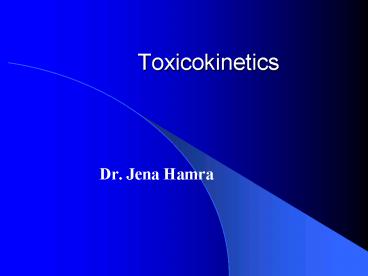Toxicokinetics - PowerPoint PPT Presentation
1 / 25
Title:
Toxicokinetics
Description:
C0 = Plasma drug concentration immediately following distribution ... Elimination constant, Vd, Cl and half-life are independent of dose. Zero order kinetics ... – PowerPoint PPT presentation
Number of Views:434
Avg rating:3.0/5.0
Title: Toxicokinetics
1
Toxicokinetics
- Dr. Jena Hamra
2
Toxokinetics
- Mathematical description or model that relates
the plasma concentration of a chemical to the
rates of drug disposition - Absorption
- Distribution
- Biotransformation
- Elimination
3
(No Transcript)
4
Distribution
- Movement of chemical to organs or tissues from
the circulation - Occurs simultaneously with absorption
- Three primary compartments
- Plasma water
- Extracellular water
- Intracellular water
5
Toxicokinetics
- Two models
- Classic model
- Compartmental
- Simplest
- Physiological (PBPK)
- Compartments based on specific organs or tissues
- Based on physiological parameters
- Can predict tissue concentrations
6
Classic Toxicokinetics
- Compartmental
- Central compartment
- Plasma
- Tissues with high blood flow
- Rapid equilibration
- Peripheral compartments
- Tissues that equilibrate more slowly
- Equilibrate at different rates
7
One Compartment Models
- Simplest
- Assume chemical does not leave the central
compartment - Changes in plasma concentrations reflect
proportional changes in tissue chemical
concentrations - Semi-logarithmic graph of time course yields a
straight line
8
(No Transcript)
9
(No Transcript)
10
Multi-Compartment Models
- Drugs absorbed into central compartment and
distributed to peripheral compartments - Elimination from central compartment
- Semi-logarithmic graph of time course data does
NOT yield a straight line
11
(No Transcript)
12
(No Transcript)
13
Volume of Distribution (Vd)
- Apparent space or volume that a chemical is
distributed into in the body - Higher the Vd, the greater the movement into all
the tissues in the body - Units Liters or Liters/Kg
- One compartment model
- Vd DoseIV/ C0
- C0 Plasma drug concentration immediately
following distribution
14
Clearance
- Rate of elimination of a chemical from the body
- Units Milliliters/minute
- Total body clearance
- Sum of clearances from all eliminating organs
- One compartment model
- Cl Vd X kel
- Two compartment model
- Cl Vd X ?
15
First and Zero Order Kinetics
- First order kinetics
- Rate of elimination of chemical is proportional
to the concentration of the chemical in the body - Elimination constant, Vd, Cl and half-life are
independent of dose - Zero order kinetics
- Rate of elimination is constant
- Independent of concentration of chemical in body
16
(No Transcript)
17
Elimination Half-life
- Time required to eliminate half of the amount of
a chemical in the body - Reduce plasma concentration by 50
- T1/2 0.693Vd/Cl 0.693/Ke
- ? Vd ? ? T1/2
18
Bioavailability
- Fraction of a dose (oral) that reaches the
systemic circulation
19
Physiologic Toxicokinetics
- Compartments based on organs and tissues
- No generic model
- Each compartment is a tissue or region of the
body with a UNIFORM concentration of the
xenobiotic - Subcompartments
- Vascular
- Interstitial
- Intracellular
20
Parameters
- Anatomic
- Size/volumes
- Physiologic
- Blood flow
- Cardiac output
- Ventilation
- Thermodynamic
- Distribution
- Transport
21
Perfusion Limited Compartments
- Flow limited
- Cell membrane permeability is much greater than
the blood flow rate to the tissue - Most tissues
- Concentration in plasma is in equilibrium with
concentration in interstitial space - Extracellular space
22
(No Transcript)
23
Diffusion Limited Compartments
- Transport of chemical across membrane is much
slower than the blood flow to the tissue
24
Specialized Compartments
- Lung
- Assumptions
- Ventilation continuous
- No absorption in conducting airways
- Flow-limited diffusion
- No storage of chemical in lung
- Alveolar/blood in rapid equilibrium
- Liver
- Saturable kinetics!
25
(No Transcript)































